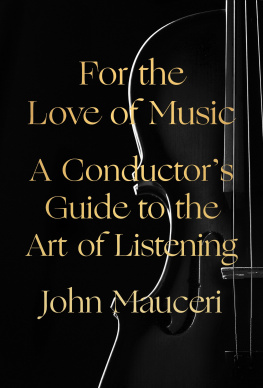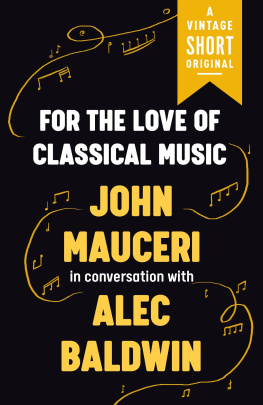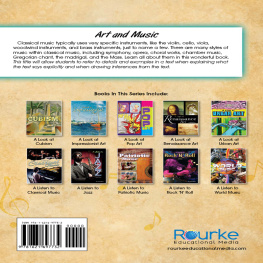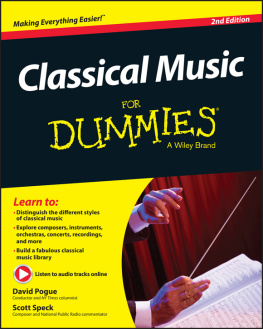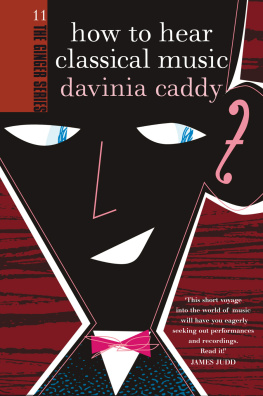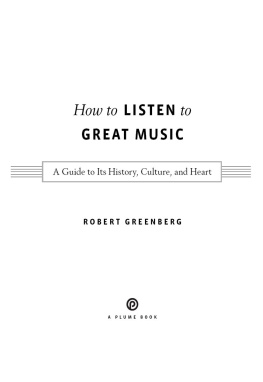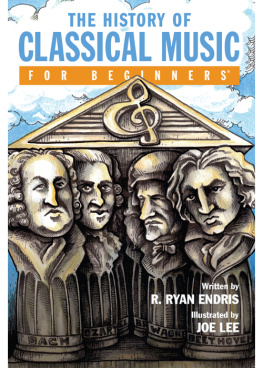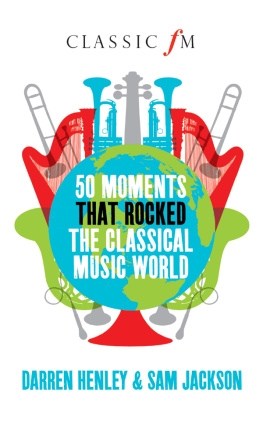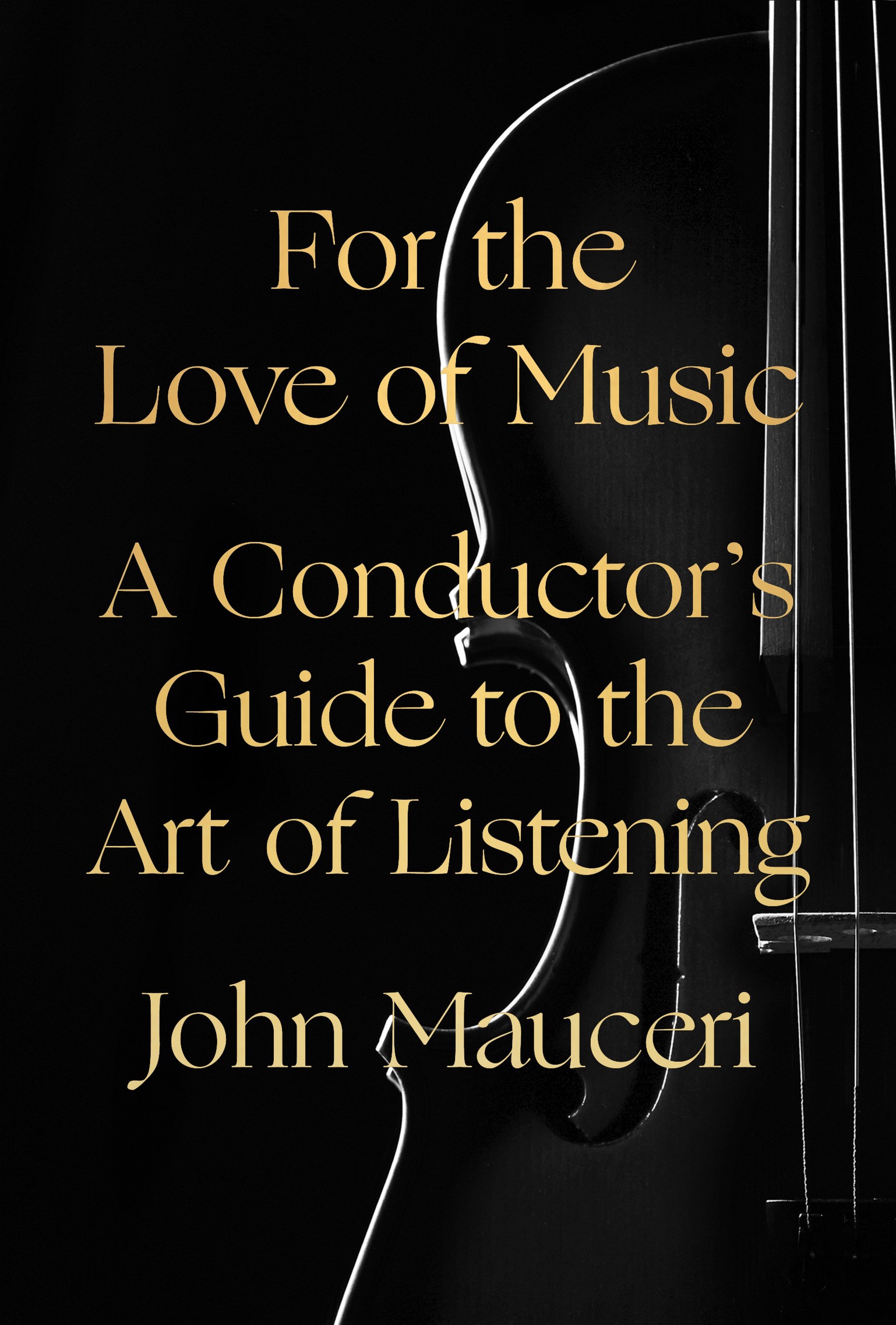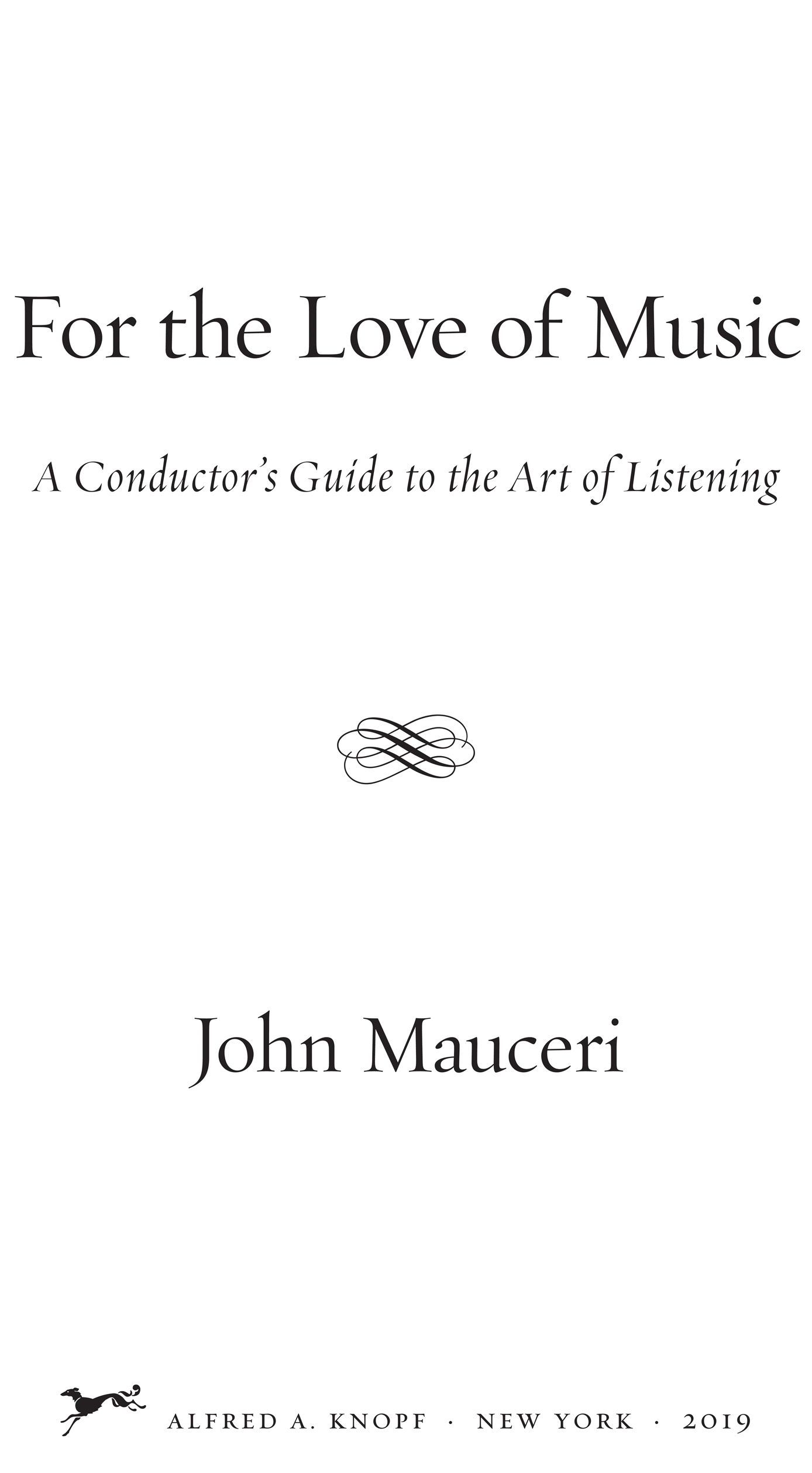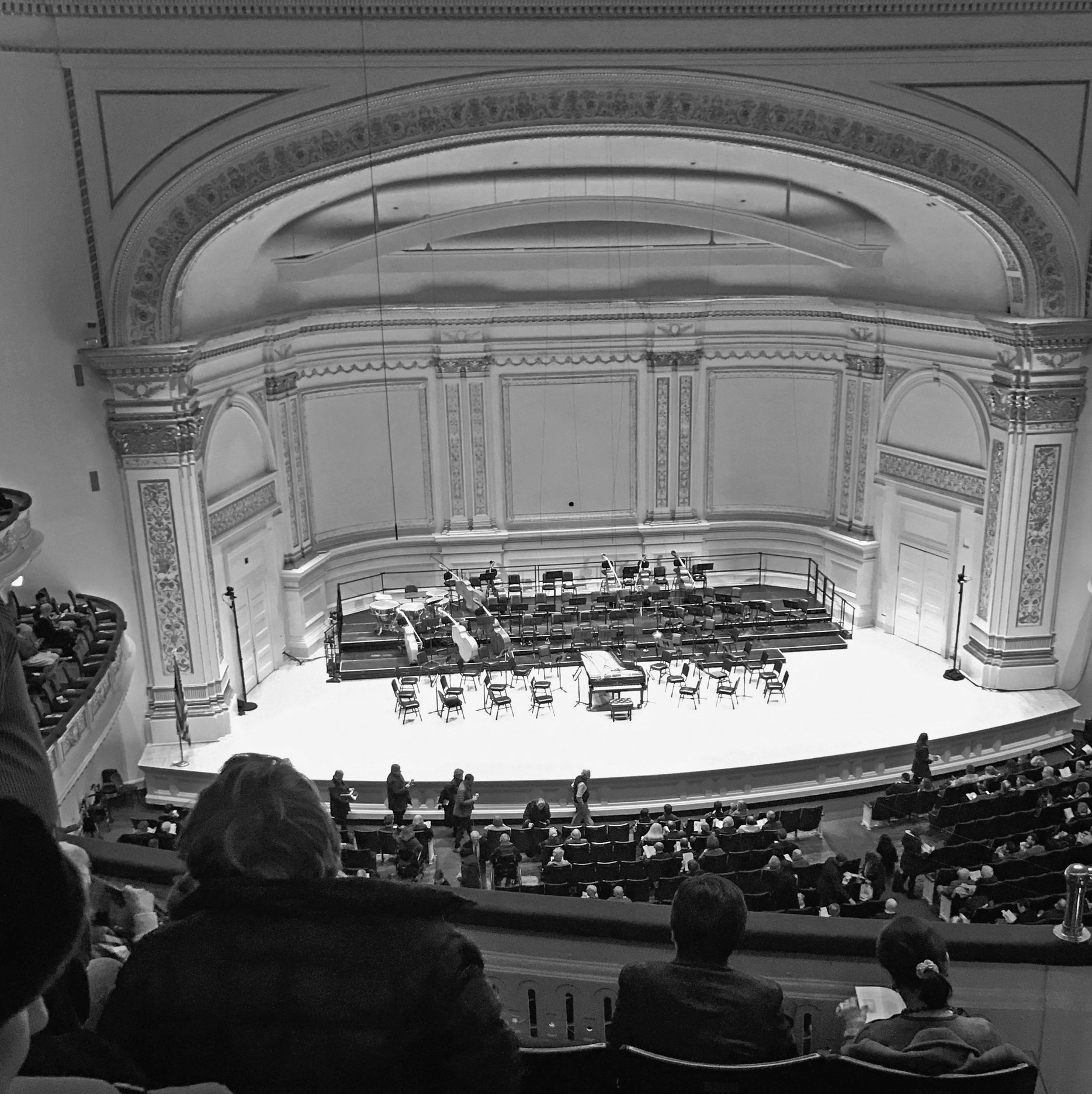ALSO BY JOHN MAUCERI
Maestros and Their Music: The Art and Alchemy of Conducting
THIS IS A BORZOI BOOK PUBLISHED BY ALFRED A. KNOPF
Copyright 2019 by John Mauceri
All rights reserved. Published in the United States by Alfred A. Knopf, a division of Penguin Random House LLC, New York, and distributed in Canada by Random House of Canada, a division of Penguin Random House Canada Limited, Toronto.
www.aaknopf.com
Knopf, Borzoi Books, and the colophon are registered trademarks of Penguin Random House, LLC.
Library of Congress Cataloging-in-Publication Data
Names: Mauceri, John, author.
Title: For the love of music : a conductors guide to the art of listening / John Mauceri.
Description: New York : Alfred A. Knopf, 2019. | Includes index.
Identifiers: LCCN 2018051290 (print) | LCCN 2018052772 (ebook) | ISBN 9780525520665 (Ebook) | ISBN 9780525520658 (hardcover)
Subjects: LCSH: Music appreciation.
Classification: LCC M T90 (ebook) | LCC M T90 . M 287 2019 (print) | DDC 781.1/dc23
LC record available at https://lccn.loc.gov/2018051290
Ebook ISBN9780525520665
Illustration Credits : Johann Anton Vllner
Cover images by Adil Yusifov and Beyla Balla/Shutterstock
Cover design by Stephanie Ross
v5.4
ep
For Aunt Rose, Aunt Jennie, and my brother Bob
and Lenny, of course
You may be sitting in a room reading this book. Imagine one note struck upon the piano. Immediately that one note is enough to change the atmosphere of the roomproving that the sound element in music is a powerful and mysterious agent, which it would be foolish to deride or belittle.
AARON COPLAND , What to Listen for in Music
Contents
Introduction
Carnegie Hall. The audience arrives. January 2017
I SAT ANONYMOUSLY in the top balcony of Carnegie Hall surrounded by 2,800 strangers who had come together on a Sunday afternoon to sit in the dark and listen to the music of Mozart and Bruckner. The sounds of the cityautomobile and truck horns, the rumble of the subway beneath our feet, the occasional sirenwere erased by the buzz of conversation in the hall, building in a gentle crescendo as a sold-out house settled in. Winter coats stuffed under our seats, a perfunctory hello extended to our temporary neighbors, we perused our programs and waited for the lights to dim. Members of the Staatskapelle Berlin, an orchestra that traces its history back to 1570, entered the stage and took their places around a grand piano with its lid removed.
Our corporeality soon melted away as the stage glowed, focusing our attention on the musicians below us. Daniel Barenboim, serving as both conductor and pianist, entered to great applause. He sat downhis back to usand, with a gesture from his right hand, there was music, Mozarts Piano Concerto no. 23.
A sweet and pulsing A-major chord rose in the air, gentle and elegant. It was no longer a matter of where we were or what year it wasthe music was timeless, eternal, and utterly beautiful. When the second movement began, with Barenboims solo statement of a sad and wistful melody of intimate musings, a different pulselike a barcarolles lullingaccompanied the give-and-take between the piano and the orchestra in a wordless aria: a meditation, really, one that seemed to embrace regrets, consolation, and gentle laughter. And without a moments hesitation, the entire ensemble leaped into the final movement: thousands of cascading notes, scampering woodwinds, and joyous melodies brought all of us into a celebration of life itselfsunshine and clouds all together in an ideal environment of civility and musicianship.
And we were only halfway through the concert.
Returning to my seat after the break, I could not help wondering at what I was now seeing on the stage. Instead of a grand piano and a small orchestra, a hundred musicians filled the entire floor space. Where there had been two French horns for Mozart, there were now eight! Woodwinds and strings had been multiplied, and my eyes began to prepare me for what my ears would soon hearan entirely different universe of sound.
Bruckner, like Mozart, was an Austrian Catholic. Unlike Mozart, he was a devout believer whose goal was to express the greatness of God in every note he composed. As a boy from a little town, he never got over the experience of being a choirboy at a nearby monastery with its magnificent baroque architecture and grand pipe organ, which he was occasionally allowed to play. The sound of his adolescence at St. Florians Augustinian monastery became the guiding acoustical and structural template for the grand and enormous symphonies of his adulthood.
The Ninth is Bruckners last symphony, left incomplete at the time of his death in 1896, and composed during a period in which he was aware of his terminal illness. When we experience its three movements we stand before the gate separating life from death.
Beginning with an almost inaudible trembling in the strings, we are in the key of D minor, and not by chance. This is the key of Beethovens last symphony, also numbered nine, and as we do with Beethoven, we enter its realm in devout quiet. It is a quiet that pulls all of us in. From its mysterious opening bars we hear a low, heroic melody on the eight horns, and within two minutes there is an earth-shattering statement by the orchestra that resets our senses to this new and immense cosmos of possibilities.
Themes of intense longing, beauty, and weariness intermingled as Brucknerthrough Barenboim and his Berlin orchestratook us on an exploration of towering majesty and human frailty in a play of dynamics that includes moments of total silence before each mighty ascent. Writers have described Bruckners symphonies as Gothic cathedrals of sound, and in many ways they arebut they are late-nineteenth-century imaginary cathedrals, as epitomized by the cathedral in Cologne that was begun in 1248 but not completed until 1880. Where there had once been stonecutters in the Dark Ages, there were now nineteenth-century engineers supervising workers who were pouring concrete into molds. That Bruckners Ninth was left incomplete makes it a perfect metaphor for the very thing it emulatedthe unfinished work of humans to serve and celebrate God.
This concert was a celebration of many things, of course. Ostensibly it marked the sixtieth anniversary of Barenboims Carnegie Hall debut in 1957 and was the culmination of a week of concerts in which he shared his mastery as a pianist and a conductor, performing works by two of the most significant composers of classical music, and he did it all with a technical skill that few musicians could ever duplicate.
Sitting there that afternoon, I also felt a communionnot just with those who were in the audience, but also with the thousands of people who have sat in that very same place ever since the opening concerts in 1891, when Tchaikovsky journeyed from Moscow to conduct his music there. Every person who sits in that seat is celebrating continuity.
As we shall see, classical music celebrates community, nature, humanitys aspirations, triumphs, and foibles, and our desire to apply form to chaos. It reaches back to the very beginnings of what it means to be human.

